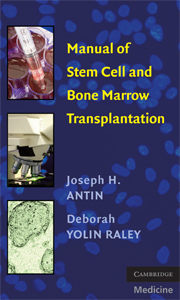Book contents
- Frontmatter
- Contents
- Acknowledgments
- Manual of Stem Cell and Bone Marrow Transplantation
- 1 Rationale for Transplantation
- 2 Types of Transplantation
- 3 HLA Matching in Allogeneic Transplantation
- 4 Stem Cell Source
- 5 Pretransplant Evaluation and Counseling of Patient and Donor
- 6 Conditioning Regimens
- 7 Stem Cell Infusion
- 8 ABO Compatibility
- 9 Engraftment
- 10 Preventative Care
- 11 Transplant-Related Complications
- 12 Graft-Versus-Host Disease – Prophylaxis and Acute
- 13 Graft-Versus-Host Disease – Chronic
- 14 Engraftment Syndrome
- 15 Infectious Disease
- 16 Graft Rejection And Failure
- 17 Gastrointestinal Complications
- 18 Pulmonary Complications
- 19 Veno-Occlusive Disease
- 20 Special Transfusion-Related Situations
- 21 Cardiovascular Complications
- 22 Neurologic Complications
- 23 Cystitis
- 24 Donor Lymphocyte Infusion
- 25 Transplantation: Regulation And Accreditation
- Appendix
- Index
13 - Graft-Versus-Host Disease – Chronic
Published online by Cambridge University Press: 23 November 2009
- Frontmatter
- Contents
- Acknowledgments
- Manual of Stem Cell and Bone Marrow Transplantation
- 1 Rationale for Transplantation
- 2 Types of Transplantation
- 3 HLA Matching in Allogeneic Transplantation
- 4 Stem Cell Source
- 5 Pretransplant Evaluation and Counseling of Patient and Donor
- 6 Conditioning Regimens
- 7 Stem Cell Infusion
- 8 ABO Compatibility
- 9 Engraftment
- 10 Preventative Care
- 11 Transplant-Related Complications
- 12 Graft-Versus-Host Disease – Prophylaxis and Acute
- 13 Graft-Versus-Host Disease – Chronic
- 14 Engraftment Syndrome
- 15 Infectious Disease
- 16 Graft Rejection And Failure
- 17 Gastrointestinal Complications
- 18 Pulmonary Complications
- 19 Veno-Occlusive Disease
- 20 Special Transfusion-Related Situations
- 21 Cardiovascular Complications
- 22 Neurologic Complications
- 23 Cystitis
- 24 Donor Lymphocyte Infusion
- 25 Transplantation: Regulation And Accreditation
- Appendix
- Index
Summary
In the past, chronic graft-versus-host disease (cGVHD) was characterized by time of onset. Generally speaking, any manifestation of GVHD after day 100 was termed cGVHD. The most recent NIH Consensus Working Group data suggests that clinical manifestations, and not the time to symptomatic onset after transplantation, determine if the syndrome is acute or chronic. In addition, a new scoring/grading system replaces the historical system of classifying a patient as having “limited” or “extensive” disease.
There is no consensus to the pathogenesis of cGVHD. T lymphocytes play a major role but evidence shows that in some patients there is coordinated B-cell and T-cell attack. In addition, there is data that suggests that cGVHD may be related to autoimmune reactions of the donor cells.
RISK FACTORS
Accepted Factors
History of grade II or greater aGVHD
Disparity at Class I or Class II human leucocyte antigen (HLA) loci
Peripheral blood stem cells versus bone marrow source
Patient diagnosis (chronic myelogenous leukemia [CML] and aplastic anemia)
Female donor → male recipient (even greater if parous)
Older recipient age
Multiparous female donor
History of acute inflammation, for example, TEN, Stevens Johnson, and others
Non-T-cell-depleted source
Donor lymphocyte infusion (DLI)
Sun exposure
Possible Risk Factors
Cytomegalovirus (CMV) seropositivity
History of splenectomy
Corticosteroids as aGVHD prophylaxis
High number of CD 34+ cells in a peripheral blood stem cell infusion
- Type
- Chapter
- Information
- Manual of Stem Cell and Bone Marrow Transplantation , pp. 76 - 97Publisher: Cambridge University PressPrint publication year: 2009



